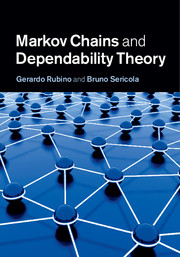Book contents
- Frontmatter
- Contents
- 1 Introduction
- 2 Discrete-time Markov chains
- 3 Continuous-time Markov chains
- 4 State aggregation
- 5 Sojourn times in subsets of states
- 6 Occupation times of subsets of states – interval availability
- 7 Linear combination of occupation times – performability
- 8 Stationarity detection
- 9 Simulation techniques
- 10 Bounding techniques
- References
- Index
7 - Linear combination of occupation times – performability
Published online by Cambridge University Press: 05 July 2014
- Frontmatter
- Contents
- 1 Introduction
- 2 Discrete-time Markov chains
- 3 Continuous-time Markov chains
- 4 State aggregation
- 5 Sojourn times in subsets of states
- 6 Occupation times of subsets of states – interval availability
- 7 Linear combination of occupation times – performability
- 8 Stationarity detection
- 9 Simulation techniques
- 10 Bounding techniques
- References
- Index
Summary
As recognized in a large number of studies, the quantitative evaluation of fault-tolerant computer systems needs to deal simultaneously with aspects of both performance and dependability. For this purpose, Meyer [66] developed the concept of performability, which may be interpreted as the cumulative performance over a finite mission time. The increasing need to evaluate cumulative measures comes from the fact that in highly available systems, steady-state measures can be very poor, even if the mission time is not small. Considering, for instance, critical applications, it is crucial for the user to ensure that the probability that the system will achieve a given performance level is high enough.
Formally, the system fault-repair behavior is assumed to be modeled by a homogeneous Markov chain. Its state space is divided into disjoint subsets, which represent the different configurations of the system. A performance level or reward rate is associated with each of these configurations. This reward rate quantifies the ability of the system to perform in the corresponding configuration. Performability is then the accumulated reward over the mission time.
Information
- Type
- Chapter
- Information
- Markov Chains and Dependability Theory , pp. 160 - 187Publisher: Cambridge University PressPrint publication year: 2014
